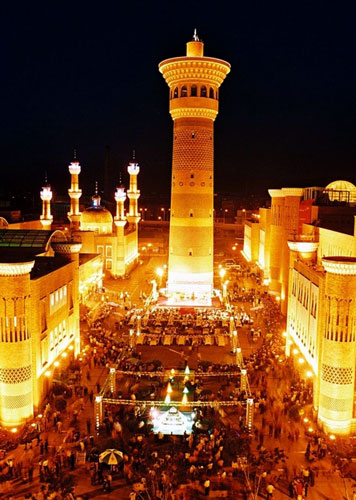ByZhang Yunxing & Wang Ke
China.org.cn Multimedia Team
Brief intro of Xinjiang
Located at the border area of northwest China and the hinterland of the Eurasian Continent, Xinjiang Uygur Autonomous Region (Xinjiang for short) covers an area of 1664900 square kilometers, accounting for one-sixth of China’s territory.
It is the largest provincial-level region in China. It borders on eight countries namely Mongolia, Russia, Kazakhstan, Kyrgyzstan, Tajikistan, Afghanistan, Pakistan and India. Its land boundary is 5600 kilometers, accounting for one-fourth of China's land boundary. It is a provincial-level region with the most neighboring countries and longest land boundary in China.

Xinjiang has a long history, multitudinous ethnic groups and a splendid culture. Called as "Western Regions" in ancient times, Xinjiang has always been a region with multi-ethnic inhabitation and multi-religious coexistence. It has enjoyed the dual-fame of "Worldwide Ethnic Groups Museum" and "Worldwide Religious Museum," and created the glorious art of western regions.
In 60 B.C., the Western Han Dynasty set up "the Western Regions Frontier Command," indicating the beginning of national sovereignty exertion by the Western Han Dynasty over the West regions, and making Xinjiang inseparable part of the united multi-ethnic China.
Today, Xinjiang, China, is composed of 47 ethnic groups including 13 major ethnic groups such as Uygur, Han, Kazak, Hui, Mongolian, Khalkhas, Xibe, Tajik, Uzbek, Manchu, Daur, Tartar and Russian. They jointly form a great ethnic family with mutual respect and peaceful coexistence. According to statistics of 2006, the total population of Xinjiang was 20.5 million, in which population of ethnic groups rather than ethnic Han was 12.3784 million.
Presently Xinjiang has 5 autonomous prefectures, 7 prefectures, 2 prefecture-level cities, 20 county-level cities, 6 autonomous counties and 62 counties under its jurisdiction. It is one of the five minority autonomous regions in China. The capital city of Urumqi is the political, economic, cultural and transport center of Xinjiang Uygur Autonomous Region.
With its vast territory, rich resources and abundant energy, Xinjiang enjoys exceptional development advantages. Over the past 50 years since the founding of the people’s republic of China, all ethnic groups of Xinjiang have united and cooperated in hard exploration, jointly wrote the glorious canto of development, construction and frontier defense. The social outlook of Xinjiang has undergone earth-shaking changes. Today, economic development, social stability, ethnic unity, harmony of all ethnic groups and all-round progress in all undertakings have fully presented Xinjiang’s scene of prosperity.